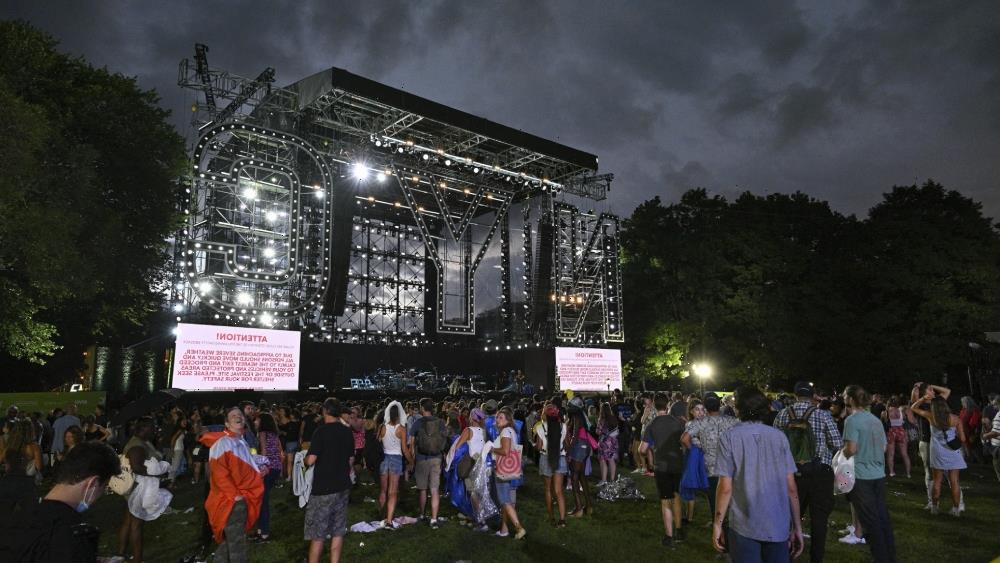“We Love NYC: The Homecoming Concert,” the Central Park concert scheduled to be headlined by Bruce Springsteen, Paul Simon, Patti Smith and others, originally was intended to celebrate all that is unique and glorious about the city that 8 million people call home. Unfortunately, on Saturday night, that also included the region’s typical late-summer downpours.
But even by area standards, the torrents of rain that poured down were historic — according to the National Weather Service, the park experienced 1.94 inches of rainfall between 10 p.m. and 11 p.m., the most ever recorded in a single hour since the service started tracking such metrics 150 years ago — and, due to the danger of lightning, the park was quickly emptied of the estimated 60,000 concertgoers in attendance after brief sets from Jennifer Hudson, Carlos Santana, LL Cool J, Polo G, Andrea Bocelli, Earth Wind & Fire, Journey and Barry Manilow, among others. The above headliners never got to perform.
As the storm approached, a series of lightning-fast decisions had to be made by show producer Doug Davis as well as executive producer Clive Davis and representatives of the city, including Mayor Bill de Blasio. At around 7:30 p.m., in the middle of Barry Manilow’s performance, the decision was made to stop the music and tell the audience to seek shelter outside the park, while concert organizers spent the next two hours trying to figure out a way to continue the performances without a live audience but over CNN, which was broadcasting the concert live to 200 countries.
Doug Davis — who plays a key role in organizing his father Clive’s star-studded annual Grammy parties — was crossing his fingers for another band to show up: a rain-free band of weather that would allow an hour of respite, just enough time to deliver shortened sets by headliners like Patti Smith, Elvis Costello, Bruce Springsteen and the Killers, who were all still onsite.
“Bruce did come and was in his dressing room — he was there for a while,” Davis tells Variety. “Paul Simon lives across the street from the park, so he was in his apartment. Jimmy Fallon was in his car. We had so many people on site on standby to see if we could pull it off.”
Pulling it off would have meant moving the performances from the main stage to a VIP tent erected for guests, who were cleared out along with the audience. Davis, who was tracking the storm via satellite images on a laptop, explains, “We lost the main stage to lightning, but the VIP tent was [safe]. So on the fly, I was rejiggering the show, picking the songs, getting CNN to go commercial-free. … We all had a mentality that we had put together a once-in-a-century event and we should we should keep it going. We knew the world was watching. CNN was expecting 200 million people to tune in. We had talent on site and a window coming where we could put them on stage. We were going to try to capture it. It just closed in on us.”
Davis missed what he calls “the whole spectacle” of CNN anchors Anderson Cooper and Chloe Melas, who vamped live for the better part of three hours, but says that network chief Jeff Zucker was “over the moon” and that Cooper “was having the time of his life.” Adds Davis: “[People] said it was some of the most compelling television they ever saw.”
Certainly that’s one way to describe Gayle King FaceTiming an impromptu acoustic performance by the Killers, who played their hit 2004 “Mr. Brightside” from a backstage dressing room, live to the world. In a sense, it seems the talent wanted just as badly to take the stage in whatever way they could. That turned the concert “into its own legend,” says Davis, noting that the two hours and 45 minutes that did take place “was phenomenal for what it was — nobody left hungry.” In fact, there was a group of attendees that stayed close until the very end, chanting “NYC” defiantly.
So was there a contingency plan? Organizers had a “rain or shine” policy, but lightning was another matter. “I was with the mayor on the stage when we saw the lightning, and we knew it wasn’t going to be safe,” he says, pointing to $50 million of video screens and production equipment and the dozens of crew tasked with breaking down the production.
If anything, Davis’ own walk exiting the park late that night, after thanking the crew, musicians and staff — during which he waded through knee-high water — proved the freak storm was in itself something New Yorkers experience once in 100 years. “We left after 11 p.m. and rivers of brown water were coming through — a flash flood of epic proportions,” he says.
On Sunday morning, Davis says he woke up with an “empty feeling of sadness.” Reflecting on the many weeks and countless hours that went into planning and staging the event, he adds: “We really were putting on Woodstock. We were there to give the greatest concert of all-time. And it was memorable. It was a moment that nobody will ever forget. And for that, I’m really proud.”
Source: Read Full Article
